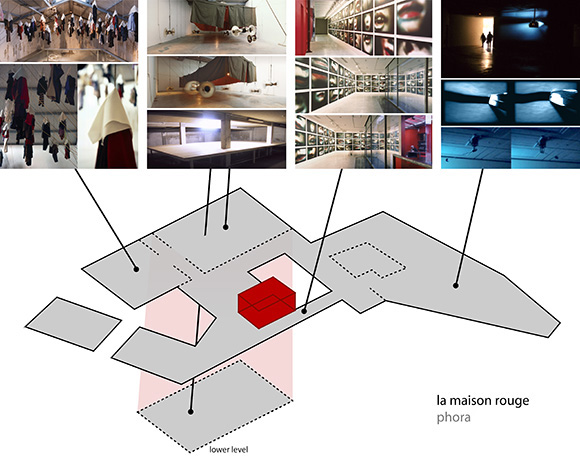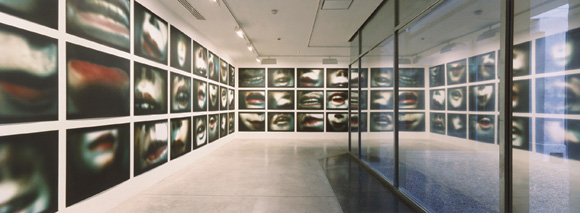
Materials: four spinning speakers, sound, turning video projection, 130 iris prints, a suspended refugee tent, seven spinning double belled sousaphone ends, clothing, wood table

Materials: four spinning speakers, sound, turning video projection, 130 iris prints, a suspended refugee tent, seven spinning double belled sousaphone ends, clothing, wood table
Inspired by the history of La Maison Rouge, the Bastille and the Bastille Opera, Hamilton transformed the exhibition spaces into platforms from which to explore the genesis of vocalization and vocal expression.

Lining the entrance corridor were large images of the still mouths of medieval wooden figures. The images, made by moving a miniature video camera in close proximity to the figures, created the passing illusion of the mouth's opening or closing. Two short walls and one long wall of the garden corridor were covered with a film that retained some transparency while reflecting the surrounding mouths like a mirror.

The eccentric low space remained dark except for the single light traced by a spinning projection suspended from the center of the space. The projection, a video of a line being drawn in and out of recognition and legibility, momentarily illuminated a circular rotation of four ceiling-mounted spinning speakers that sounded voices echoing in a Doppler effect.
In the two main galleries, a system of ropes and pulleys suspended clothing and a large canvas tent. Suspended from the ceiling were double-belled spinning sousaphones that played merging multi-lingual voices, murmurs, and incantations.

Photo credits: Thibault Jeanson
Y.,Y. "Ann Hamilton, Phora." Zurban (16 Mars 2005)
Micucci, Marjorie. "Ann Hamilton, Phora, La maison rouge, Paris." Questions lle femmes (Avril 2005)
J., M. "Ann Hamilton a la Maison rouge." l'humanité hebdo (9 Avril 2005)
Guénard Éloïse. "Phora: Exposition personnelle: Ann Hamilton." Art 21 Magazine critique d'art contemporain (Mars/Avril 2005)
Domino, Christophe. "Maison rouge Hamilton a mis le ton." Le Journal des Arts (18 du 31 Mars 2005)
Cooke, Lynne. "Ann Hamilton: La Maison Rouge, Paris." Artforum (April 2005)